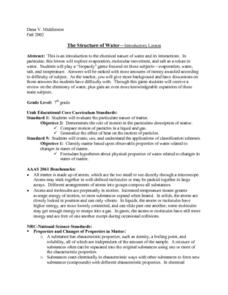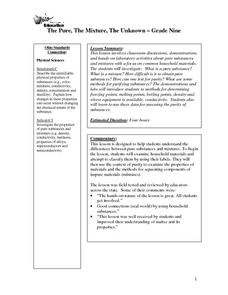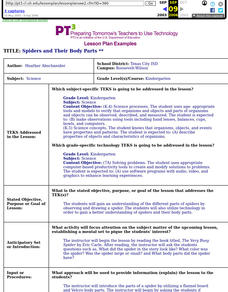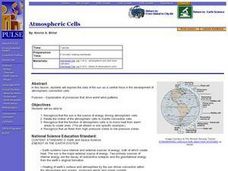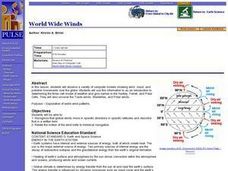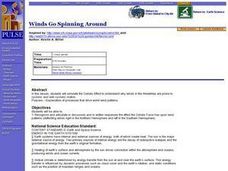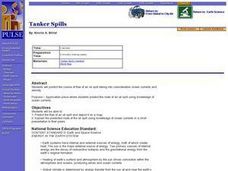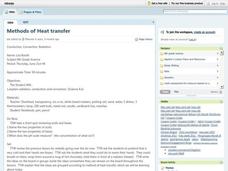Curated OER
Buoyant Force
Students investigate the scientific concept of why some objects float when put in a liquid solution. They apply the laws of motion and force while conducting classroom activities. Students also take notes and answer target questions to...
Curated OER
Hot Gas Or Cold Gas Lab
Young scholars engage in a lab project to study chemical reactions. They use guided questions to help facilitate the lab experience and come to the correct outcomes. The instructional activity does not contain a true understandable...
Curated OER
Effects of the Southern Pacific Railroad Causeway
Fifth graders describe the appearance of a substance before and after a physical change. They re-create the Southern Pacific Railroad Causeway across the Great Salt Lake. They determine for themselves how the water is exchanged...
Curated OER
Will it SINK or Float?
Students predict whether objects will sink or float in water. They classify objects as sinking or floating in water. Students identify and explain similarities between objects that sink and float.
Curated OER
Making New Electricity
Students investigate the concepts of energy conversion and conservation. They research the history of energy conversions into electrical energy. They design experiments in order to replicate a conversion of energy into electricity.
Curated OER
Molar Ratio
Students conduct an experiment in which they react sodium bicarbonate with hydrochloric acid to determine the molar ration between the two reactants. Students must write correct formula and a balanced chemical equation and explain how...
Curated OER
Stellar Spectral Fingerprints
Students listen as the teacher introduces Newton's early discovery of the diffraction of light. They use multiple sources of light (fluorescent, incandescent, sunlight, etc) to bend the light. They first use a prism then a diffraction...
Curated OER
Making Changes
Students observe and record the changes they see when adding heat and cold to objects. For this changes lesson plan, students experiment with different objects and see if heat and cold change the makeup of the object. They then record...
Curated OER
The Chemical Nature of Water
Seventh graders simulate a Jeopardy game to examine the chemical nature of water. Among the topics featured are evaporation, water, salt, and temperature. finally, as review, 7th graders answer a battery of questions presented by the...
Curated OER
Waves
Students identify the different parts of a wave. In this physics lesson, students explain how animals communicate using sound waves. They discuss the effect of Navy's sonar on dolphins and whales.
Curated OER
Identifying Acids and Bases
Sixth graders observe the physical and chemical change that can occur in an acid and a base. In this acids and bases lesson plan, 6th graders use cabbage juice to identify, compare, and contrast acids and bases.
Curated OER
Mixtures
Sixth graders experiment with mixtures. In this chemistry instructional activity, 6th graders determine which mixtures are considered heterogeneous, a suspension, a solution or a colloid. Students create a data sheet of what they discover.
Curated OER
The Pure, The Mixture, The Unknown
Ninth graders participate in classroom discussions, demonstrations and hands-on laboratory activities about pure substances and mixtures with a focus on common household materials. They investigate: What is a pure substance? What is a...
Curated OER
Changes of State
Learners examine molecules and the changes in energy of a system. In this energy systems lesson plan students complete a lab activity and describe changes of state.
Curated OER
Electricity/Magnetism
Fourth graders explore magnets as fundamental parts of generators and how they are used to produce current electricity. They distinguish between the north and south pole of magnets and the difference between repel and attract. Students...
Curated OER
Spiders and Their Body Parts
Students gain an understanding of the different parts of spiders by observing and drawing a spider. They utilize technology in order to gain a better understanding of spiders and their body parts.
Curated OER
Atmospheric Cells
Students recognize that the sun is the source of energy driving atmosphere cells. They relate the motion of the atmospheric cells to mantle convection cells. Students recognize that the function of atmospheric cells is to move heat from...
Curated OER
World Wide Winds
Students recognize that global winds move in specific directions in specific latitudes and describe that in a written form. They relate the motion of the wind belts to historical navigation.
Curated OER
Winds Go Spinning Around
Students simulate the Coriolis Effect to comprehend why winds in the Westerlies are prone to cyclonic and anti-cyclonic motion. They arrive at an explanation of processes that drive world wind patterns
Curated OER
Tanker Spills
Students predict the flow of an oil spill and depict it on a map. They explain the predicted route of the oil spill using knowledge of ocean currents in a short presentation to their peers.
Curated OER
Methods of Heat Transfer
Eighth graders are introduced to the various types of heat transfer methods. After taking a quiz, they pretend their hands are cold and offer suggestions on how to warm them up. They explain each type of heat transfer method and give...
Curated OER
Mixtures
In this mixtures worksheet, students fill in 7 blanks, determine if 4 statements are true or false, match 7 terms with the appropriate definitions, and solve 2 problems. These include topics such as homogeneous and heterogeneous...
Curated OER
Frozen Film
Students discover how light reflects off surfaces. In this hands-on demonstration, students examine how variations in color are produced by light interference.










